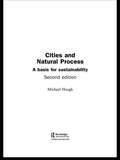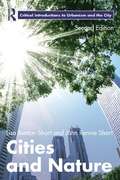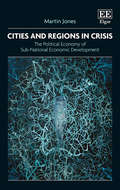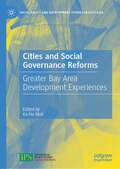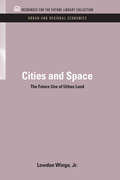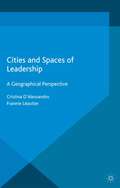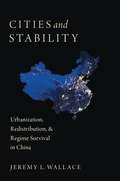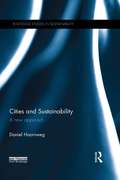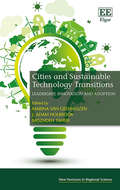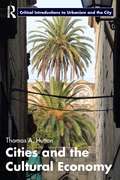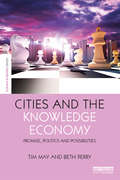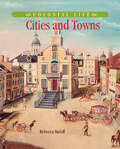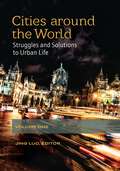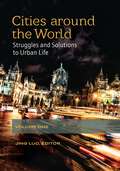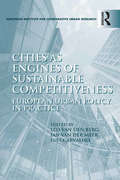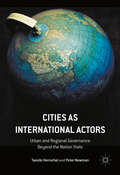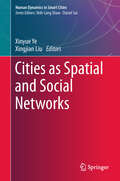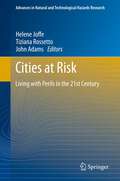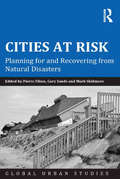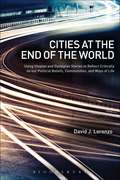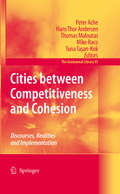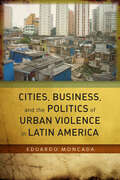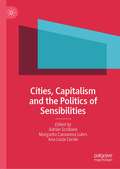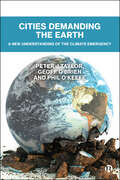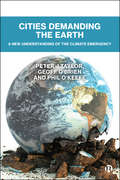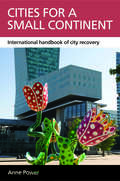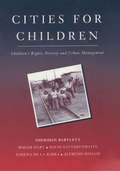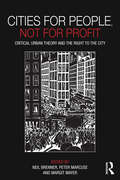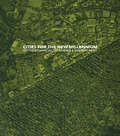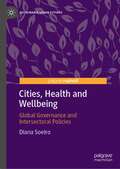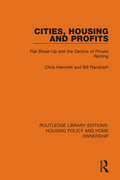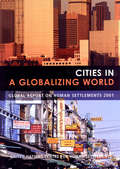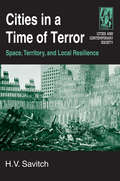- Table View
- List View
Cities and Natural Process
by Michael HoughCities and Natural Process is a book for all concerned with the future of our cities, their design and sustainability, and our quality of life within them. Michael Hough describes how economic and technological values have squeezed any real sense of nature out of the modern city, the ways in which this has led to a divisive separation of countryside and city, wasted much of the city's resources, and shaped an urban aesthetic which is sharply at odds with both natural and social processes. Against this is set an alternative history of ecological values informing proven approaches to urban design which work with nature in the city.
Cities and Natural Process
by Michael HoughCities and Natural Process is a book for all concerned with the future of our cities, their design and sustainability, and our quality of life within them. Michael Hough describes how economic and technological values have squeezed any real sense of nature out of the modern city, the ways in which this has led to a divisive separation of countryside and city, wasted much of the city's resources, and shaped an urban aesthetic which is sharply at odds with both natural and social processes. Against this is set an alternative history of ecological values informing proven approaches to urban design which work with nature in the city.
Cities and Nature (Routledge Critical Introductions to Urbanism and the City)
by Lisa Benton-Short John Rennie ShortCities and Nature connects environmental processes with social and political actions. The book reconnects science and social science to demonstrate how the city is part of the environment and how it is subject to environmental constraints and opportunities. This second edition has been extensively revised and updated with in-depth examination of theory and critical themes. Greater discussion is given to urbanization trends and megacities; the post-industrial city and global economic changes; developing cities and slums; urban political ecology; the role of the city in climate change; and sustainability. The book explores the historical relationship between cities and nature, contemporary challenges to this relationship, and attempts taken to create more sustainable cities. The historical context situates urban development and its impact on the environment, and in turn the environmental impact on people in cities. This provides a foundation from which to understand contemporary issues, such as urban political ecology, hazards and disasters, water quality and supply, air pollution and climate change. The book then considers sustainability and how it has been informed by different theoretical approaches. Issues of environmental justice and the role of gender and race are explored. The final chapter examines the ways in which cities are practicing sustainability, from light "greening" efforts such as planting trees, to more comprehensive sustainability plans that integrate the multiple dimensions of sustainability. The text contains case studies from around the globe, with many drawn from cities in the developing world, as well as reviews of recent research, updated and expanded further reading to highlight relevant films, websites and journal articles. This book is an asset to students and researchers in geography, environmental studies, urban studies and planning and sustainability.
Cities and Nature (Routledge Critical Introductions to Urbanism and the City)
by Lisa Benton-Short John Rennie ShortCities and Nature connects environmental processes with social and political actions. The book reconnects science and social science to demonstrate how the city is part of the environment and how it is subject to environmental constraints and opportunities. This second edition has been extensively revised and updated with in-depth examination of theory and critical themes. Greater discussion is given to urbanization trends and megacities; the post-industrial city and global economic changes; developing cities and slums; urban political ecology; the role of the city in climate change; and sustainability. The book explores the historical relationship between cities and nature, contemporary challenges to this relationship, and attempts taken to create more sustainable cities. The historical context situates urban development and its impact on the environment, and in turn the environmental impact on people in cities. This provides a foundation from which to understand contemporary issues, such as urban political ecology, hazards and disasters, water quality and supply, air pollution and climate change. The book then considers sustainability and how it has been informed by different theoretical approaches. Issues of environmental justice and the role of gender and race are explored. The final chapter examines the ways in which cities are practicing sustainability, from light "greening" efforts such as planting trees, to more comprehensive sustainability plans that integrate the multiple dimensions of sustainability. The text contains case studies from around the globe, with many drawn from cities in the developing world, as well as reviews of recent research, updated and expanded further reading to highlight relevant films, websites and journal articles. This book is an asset to students and researchers in geography, environmental studies, urban studies and planning and sustainability.
Cities and Regions in Crisis: The Political Economy of Sub-National Economic Development
by Martin JonesOffering a geographical political economy analysis, this book explores the mechanisms, institutions, and spaces of subnational economic development. Martin Jones innovatively examines how policy-makers frame problems and offer intervention solutions in different cities and regions. Drawing on different approaches to state intervention, neoliberalism, crisis and contradiction theories, and notions of depoliticisation, this book explains policy failure and how it is impacted by flux surrounding economic development. With constant changes to legislation, institutional initiatives, and ministerial responsibility, local and regional economic development is shown to be at a critical crossroads. Theoretically innovative and empirically focused, this timely book is a must-read for researchers and policy-makers of urban geography, regional development, political economy and public policy.
Cities and Social Governance Reforms: Greater Bay Area Development Experiences (Social Policy and Development Studies in East Asia)
by Ka Ho MokThis book examines critically how the Chinese government has proactively engaged the nine cities and two special administrative regions in the Greater Bay Area (GBA) in Southern China for deeper collaborations in order to transform the country from the “World Factory” to become a leading world economy in innovation and entrepreneurialism. While most of the existing research related to China’s GBA development offers the economic and technological advancement perspectives, this book focuses on critical reflections upon how the call for megacity development and deeper regional collaborations in the Bay Area will affect people’s livelihoods, social integration and urban governance. The central theme of this book builds around “Cities, Social Cohesion and Governance.” Based upon policy and document analysis, first-hand fieldwork and surveys, and intensive interviews with major stakeholders responsible for pushing the Greater Bay Area development, this book offers not only regional perspectives in analyzing the Greater Bay Area development through comparing and contrasting development experiences within the country’s different bay economies like the Shanghai and Zhejiang Bay Area and Beijing and Bohai Bay Area. The present book also draws comparative and international insights from other well- established bay economies like Tokyo Bay, Florida Bay and New York Bay Areas when analyzing the development in the GBA in China.
Cities and Space: The Future Use of Urban Land (RFF Urban and Regional Economics Set)
by Lowdon Wingo Jr.Discusses aims of urban planning and ways to achieve improved city living. Originally published in 1963
Cities and Space: The Future Use of Urban Land (RFF Urban and Regional Economics Set)
by Lowdon Wingo Jr.Discusses aims of urban planning and ways to achieve improved city living. Originally published in 1963
Cities and Spaces of Leadership: A Geographical Perspective (International Political Economy Ser. (PDF))
by Cristina D'Alessandro Frannie LéautierCities and Spaces of Leadership investigates the interaction between leadership, leaders and spaces at various levels. It analyzes how spaces and places influence leaders and leadership, as well as how the presence, distribution, action, and concentration of leaders in spaces contribute to their transformation.
Cities and Stability: Urbanization, Redistribution, and Regime Survival in China
by Jeremy WallaceChina's management of urbanization is an under-appreciated factor in the regime's longevity. The Chinese Communist Party fears "Latin Americanization" -- the emergence of highly unequal megacities with their attendant slums and social unrest. Such cities threaten the survival of nondemocratic regimes. To combat the threat, many regimes, including China's, favor cities in policymaking. Cities and Stability shows this "urban bias" to be a Faustian Bargain: cities may be stabilized for a time, but the massive in-migration from the countryside that results can generate the conditions for political upheaval. Through its hukou system of internal migration restrictions, China has avoided this dilemma, simultaneously aiding urbanites and keeping farmers in the countryside. The system helped prevent social upheaval even during the Great Recession, when tens of millions of laid-off migrant workers dispersed from coastal cities. Jeremy Wallace's powerful account forces us to rethink the relationship between cities and political stability throughout the developing world.
Cities and Stability: Urbanization, Redistribution, and Regime Survival in China
by Jeremy WallaceChina's management of urbanization is an under-appreciated factor in the regime's longevity. The Chinese Communist Party fears "Latin Americanization" -- the emergence of highly unequal megacities with their attendant slums and social unrest. Such cities threaten the survival of nondemocratic regimes. To combat the threat, many regimes, including China's, favor cities in policymaking. Cities and Stability shows this "urban bias" to be a Faustian Bargain: cities may be stabilized for a time, but the massive in-migration from the countryside that results can generate the conditions for political upheaval. Through its hukou system of internal migration restrictions, China has avoided this dilemma, simultaneously aiding urbanites and keeping farmers in the countryside. The system helped prevent social upheaval even during the Great Recession, when tens of millions of laid-off migrant workers dispersed from coastal cities. Jeremy Wallace's powerful account forces us to rethink the relationship between cities and political stability throughout the developing world.
Cities and Sustainability: A new approach (Routledge Studies in Sustainability)
by Daniel HoornwegCities are the most likely actors to design and bring about lasting sustainability. An agreement among the world’s larger cities is possible, and likely a necessary but insufficient condition to achieve sustainable development. Cities and Sustainability explores the ways in which cities are both the biggest threat to sustainability, and the most powerful tool to get us to sustainable development. Employing an innovative methodology to a complex issue, the book proposes new metrics and approaches that assume cities as fundamental in the search for sustainability. Providing population projections for the world’s larger cities and a hierarchy of sustainable cities, the author develops two new tools: (i) a cities approach to physical and socio-economic boundaries, and (ii) sustainability costs curves. These tools are designed to be implemented in a multi-stakeholder, integrated partnership that truly maximizes the benefits of cities in the quest for sustainability. Applying the tools outlined in the book to case studies from Dakar, Mumbai, Sao Paulo, Shanghai and Toronto, this volume will be of great relevance to students, scholars and practitioners with an interest in urban and city management, climate change, and environment and sustainability more broadly.
Cities and Sustainability: A new approach (Routledge Studies in Sustainability)
by Daniel HoornwegCities are the most likely actors to design and bring about lasting sustainability. An agreement among the world’s larger cities is possible, and likely a necessary but insufficient condition to achieve sustainable development. Cities and Sustainability explores the ways in which cities are both the biggest threat to sustainability, and the most powerful tool to get us to sustainable development. Employing an innovative methodology to a complex issue, the book proposes new metrics and approaches that assume cities as fundamental in the search for sustainability. Providing population projections for the world’s larger cities and a hierarchy of sustainable cities, the author develops two new tools: (i) a cities approach to physical and socio-economic boundaries, and (ii) sustainability costs curves. These tools are designed to be implemented in a multi-stakeholder, integrated partnership that truly maximizes the benefits of cities in the quest for sustainability. Applying the tools outlined in the book to case studies from Dakar, Mumbai, Sao Paulo, Shanghai and Toronto, this volume will be of great relevance to students, scholars and practitioners with an interest in urban and city management, climate change, and environment and sustainability more broadly.
Cities and Sustainable Technology Transitions: Leadership, Innovation and Adoption (New Horizons in Regional Science series)
by Marina Van Geenhuizen J. Adam Holbrook Mozhdeh TaheriCities are undoubted key players in technology creation and adoption for sustainable transitions. This book addresses both the active and passive roles of cities in technology innovation, commercialisation, mass-production and adoption. In particular, it examines elements of three socio-technical systems, energy, transport and healthcare. The authors investigate cities in Europe, Asia and North America, providing an in depth understanding of the differences in leadership roles that cities adopt across the globe. The book breaks new ground in the analysis of topical issues such as local ‘cradle’ conditions, incentive schemes, niche-development, living labs, impact bonds, grass-roots intermediation and adaptive policy making. Researchers and students involved in the urban studies, socio-technical transitions and sustainability would greatly benefit from reading this book. The variety of practical examples also makes this book an important tool for city policy makers, as well as public policy and public sector scholars.
Cities and the Cultural Economy (Routledge Critical Introductions to Urbanism and the City)
by Thomas A. HuttonThe cultural economy forms a leading trajectory of urban development, and has emerged as a key facet of globalizing cities. Cultural industries include new media, digital arts, music and film, and the design industries and professions, as well as allied consumption and spectacle in the city. The cultural economy now represents the third-largest sector in many metropolitan cities of the West including London, Berlin, New York, San Francisco, and Melbourne, and is increasingly influential in the development of East Asian cities (Tokyo, Shanghai, Hong Kong and Singapore), as well as the mega-cities of the Global South (e.g. Mumbai, Capetown, and São Paulo). Cities and the Cultural Economy provides a critical integration of the burgeoning research and policy literatures in one of the most prominent sub-fields of contemporary urban studies. Policies for cultural economy are increasingly evident within planning, development and place-marketing programs, requiring large resource commitments, but producing – on the evidence – highly uneven results. Accordingly the volume includes a critical review of how the new cultural economy is reshaping urban labour, housing and property markets, contributing to gentrification and to ‘precarious employment’ formation, as well as to broadly favorable outcomes, such as community regeneration and urban vitality. The volume acknowledges the important growth dynamics and sustainability of key creative industries. Written primarily as a text for upper-level undergraduate and Masters students in urban, economic and social geography; sociology; cultural studies; and planning, this provocative and compelling text will also be of interest to those studying urban land economics, architecture, landscape architecture and the built environment.
Cities and the Cultural Economy (Routledge Critical Introductions to Urbanism and the City)
by Thomas A. HuttonThe cultural economy forms a leading trajectory of urban development, and has emerged as a key facet of globalizing cities. Cultural industries include new media, digital arts, music and film, and the design industries and professions, as well as allied consumption and spectacle in the city. The cultural economy now represents the third-largest sector in many metropolitan cities of the West including London, Berlin, New York, San Francisco, and Melbourne, and is increasingly influential in the development of East Asian cities (Tokyo, Shanghai, Hong Kong and Singapore), as well as the mega-cities of the Global South (e.g. Mumbai, Capetown, and São Paulo). Cities and the Cultural Economy provides a critical integration of the burgeoning research and policy literatures in one of the most prominent sub-fields of contemporary urban studies. Policies for cultural economy are increasingly evident within planning, development and place-marketing programs, requiring large resource commitments, but producing – on the evidence – highly uneven results. Accordingly the volume includes a critical review of how the new cultural economy is reshaping urban labour, housing and property markets, contributing to gentrification and to ‘precarious employment’ formation, as well as to broadly favorable outcomes, such as community regeneration and urban vitality. The volume acknowledges the important growth dynamics and sustainability of key creative industries. Written primarily as a text for upper-level undergraduate and Masters students in urban, economic and social geography; sociology; cultural studies; and planning, this provocative and compelling text will also be of interest to those studying urban land economics, architecture, landscape architecture and the built environment.
Cities and the Knowledge Economy: Promise, Politics and Possibilities (The Earthscan Science in Society Series)
by Tim May Beth PerryCities and the Knowledge Economy is an in-depth, interdisciplinary, international and comparative examination of the relationship between knowledge and urban development in the contemporary era. Through the lenses of promise, politics and possibility, it examines how the knowledge economy has arisen, how different cities have sought to realise its potential, how universities play a role in its realisation and, overall, what this reveals about the relationship between politics, capitalism, space, place and knowledge in cities. The book argues that the 21st century city has been predicated on particular circuits of knowledge that constitute expertise as residing in elite and professional epistemic communities. In contrast, alternative conceptions of the knowledge society are founded on assumptions which take analysis, deliberation, democracy and the role of the citizen and communities of practice seriously. Drawing on a range of examples from cities around the world, the book reflects on these possibilities and asks what roles the practice of ‘active intermediation’, the university and a critical and engaged social scientific practice can all play in this process. The book is aimed at researchers and students from different disciplines – geography, politics, sociology, business studies, economics and planning – with interests in contemporary urbanism and the role of knowledge in understanding development, as well as urban policymakers, politicians and practitioners who are concerned with the future of our cities and seek to create coalitions of different communities oriented towards more just and sustainable futures.
Cities and the Knowledge Economy: Promise, Politics and Possibilities (The Earthscan Science in Society Series)
by Tim May Beth PerryCities and the Knowledge Economy is an in-depth, interdisciplinary, international and comparative examination of the relationship between knowledge and urban development in the contemporary era. Through the lenses of promise, politics and possibility, it examines how the knowledge economy has arisen, how different cities have sought to realise its potential, how universities play a role in its realisation and, overall, what this reveals about the relationship between politics, capitalism, space, place and knowledge in cities. The book argues that the 21st century city has been predicated on particular circuits of knowledge that constitute expertise as residing in elite and professional epistemic communities. In contrast, alternative conceptions of the knowledge society are founded on assumptions which take analysis, deliberation, democracy and the role of the citizen and communities of practice seriously. Drawing on a range of examples from cities around the world, the book reflects on these possibilities and asks what roles the practice of ‘active intermediation’, the university and a critical and engaged social scientific practice can all play in this process. The book is aimed at researchers and students from different disciplines – geography, politics, sociology, business studies, economics and planning – with interests in contemporary urbanism and the role of knowledge in understanding development, as well as urban policymakers, politicians and practitioners who are concerned with the future of our cities and seek to create coalitions of different communities oriented towards more just and sustainable futures.
Cities and Towns
by Rebecca StefoffFirst Published in 2015. Routledge is an imprint of Taylor & Francis, an Informa company.
Cities and Towns
by Rebecca StefoffFirst Published in 2015. Routledge is an imprint of Taylor & Francis, an Informa company.
Cities around the World [2 volumes]: Struggles and Solutions to Urban Life [2 volumes]
by Jing LuoThis two-volume set offers a comprehensive overview of major challenges faced by cities worldwide in the 21st century, and how cities in different geographic, economic, and political conditions are finding solutions to them.This two-volume encyclopedia examines ten critical issues that face cities across the globe today—environmental and societal struggles that affect the daily lives of city dwellers. Readers will gain a better understanding of our global neighbors and will be able to use this book in order to compare and contrast different approaches to critical issues in our world. Volume One examines employment and jobs; energy and sustainability; green spaces; housing and infrastructure; and migration and demographic changes. Volume Two discusses pollution; schools; traffic and transportation; violence, corruption, and organized crime; and waste management. Each issue begins with an introduction providing an overview of the issue from a global perspective. Following the introduction are ten alphabetically arranged world city profiles of cities that are struggling with the issue and cities that have found innovative solutions to deal with the crisis. The profiles explain how the problem came to be; consequences inhabitants face, such as compromised health, limited access to education, and high taxes with low wages; and failed and successful initiatives taken by city management.
Cities around the World [2 volumes]: Struggles and Solutions to Urban Life [2 volumes]
This two-volume set offers a comprehensive overview of major challenges faced by cities worldwide in the 21st century, and how cities in different geographic, economic, and political conditions are finding solutions to them.This two-volume encyclopedia examines ten critical issues that face cities across the globe today—environmental and societal struggles that affect the daily lives of city dwellers. Readers will gain a better understanding of our global neighbors and will be able to use this book in order to compare and contrast different approaches to critical issues in our world. Volume One examines employment and jobs; energy and sustainability; green spaces; housing and infrastructure; and migration and demographic changes. Volume Two discusses pollution; schools; traffic and transportation; violence, corruption, and organized crime; and waste management. Each issue begins with an introduction providing an overview of the issue from a global perspective. Following the introduction are ten alphabetically arranged world city profiles of cities that are struggling with the issue and cities that have found innovative solutions to deal with the crisis. The profiles explain how the problem came to be; consequences inhabitants face, such as compromised health, limited access to education, and high taxes with low wages; and failed and successful initiatives taken by city management.
Cities as Engines of Sustainable Competitiveness: European Urban Policy in Practice
by Leo van Berg Jan van MeerReflecting on two decades of ’competitiveness-oriented’ urban policies in Europe, this book investigates the current challenges cities face to sustain their economic position and how this can be balanced with social progress and environmental improvements. Complementing previous surveys on local and urban development and competitiveness-based strategies, this volume provides longer term views on the evolution of such policies at the city level, from the personal perspective of city officials in eight European cities. More concretely, it looks at how the urban dimension in EU policies have evolved over time, the kinds of urban policy supported by the EU over the last two decades and how cities have been involved with this process. The book investigates the portfolios of competitiveness-oriented policies which have been developed by European cities and how they see the link between urban/spatial development policies and sustainable competitiveness. Finally the book fleshes out a number of challenges and initiatives taken by the eight European cities and their governments in the face of current challenges in order to pave the way towards more competitive and sustainable urban economies.
Cities as Engines of Sustainable Competitiveness: European Urban Policy in Practice (Euricur Ser. (european Institute For Comparative Urban Research) Ser.)
by Leo van Berg Jan van MeerReflecting on two decades of ’competitiveness-oriented’ urban policies in Europe, this book investigates the current challenges cities face to sustain their economic position and how this can be balanced with social progress and environmental improvements. Complementing previous surveys on local and urban development and competitiveness-based strategies, this volume provides longer term views on the evolution of such policies at the city level, from the personal perspective of city officials in eight European cities. More concretely, it looks at how the urban dimension in EU policies have evolved over time, the kinds of urban policy supported by the EU over the last two decades and how cities have been involved with this process. The book investigates the portfolios of competitiveness-oriented policies which have been developed by European cities and how they see the link between urban/spatial development policies and sustainable competitiveness. Finally the book fleshes out a number of challenges and initiatives taken by the eight European cities and their governments in the face of current challenges in order to pave the way towards more competitive and sustainable urban economies.
Cities as International Actors: Urban and Regional Governance Beyond the Nation State
by Peter Newman Tassilo HerrschelThis book explores the growing role of cities and regions as sub-national actors in shaping global governance. Far from being merely carried along by global forces, cities have become active players in making and maintaining the networks and connections that give shape to contemporary globalization. Exploring examples from Europe, North America and beyond, the authors reconcile the two separate, yet complimentary, theoretical and analytical lenses adopted by Urban Studies and International Relations, as they address the nature of ‘cities’ and ‘internationality’. The authors challenge academic debate that is reluctant to cross disciplinary boundaries and thus offer more relevant answers to the new phenomenon of international city action, and how it weakens the traditional prerogative of the state as primary actor in the international realm. Conclusions focus on how this new internationality opens opportunities for cities and regions but also contains potential pitfalls that can constrain policy options and challenge the legitimacy of policy making at all scales.
Cities as Spatial and Social Networks (Human Dynamics in Smart Cities)
by Xinyue Ye Xingjian LiuThis book reports on the latest, cutting-edge scholarship on integrating social network and spatial analyses in the built environment. It sheds light on conceptualization and Implementation of such integration, integration for intra-city level analysis, as well as integration for inter-city level analysis. It explores the use of new data sources concerning human and urban dynamics and provides a discussion of how social network and spatial analyses could be synthesized for a more nuanced understanding of the built environment. As such this book will be a valuable resource for scholars focusing on city-related networks in a number of ‘urban’ disciplines, including but not limited to urban geography, urban informatics, urban planning, urban sociology, and urban studies.
Cities at Risk: Living with Perils in the 21st Century (Advances in Natural and Technological Hazards Research #33)
by Helene Joffe, Tiziana Rossetto and John AdamsWith the major growth of the world’s population over the past century, as well as rapid urbanisation, people increasingly live in crowded cities. This trend is often accompanied by proliferation of poorly built housing, uncontrolled use of land, occupation of unsafe environments and overstretched services. When a natural hazard strikes such a city many people are vulnerable to loss of life and property. This book explores what these people think and feel about the threats that they face. How do they live with perils ranging from earthquakes to monsoons, from floods to hurricanes, in the 21st century?The authors are drawn from a large range of disciplines: Psychology, Engineering, Geography, Anthropology and Urban Planning. They also reflect on how perils are represented in multiple cultures: the United States, Japan, Turkey, Bangladesh, the United Kingdom and New Zealand. The book therefore not only brings to light the ways that different cultures represent natural hazards but also the different ways in which various disciplines write about living with perils in the 21st century.The book is addressed both to researchers and to organizations involved with risk management and risk mitigation.
Cities at Risk: Planning for and Recovering from Natural Disasters (Global Urban Studies)
by Gary Sands Pierre FilionAs levels of urbanization increase around the world, the growing concentrations of population and economic activity increases vulnerability to natural disasters. Interdependencies among urban populations mean that damage to the built environment, including water, sewer and energy infrastructure, can affect millions. Even if there is no change in the rate of occurrence of natural disasters (an unlikely prospect in the face of ongoing climate change) the potential for human and economic loss will continue to increase, along with the time required to recover. How do cities prepare for and recover from natural disasters? In this book, the authors provide a broad overview of the issues related to the impacts of disasters on cities around the world, from assessing risks to accounting for damages. The comparative approach across different types of disasters in a range of urban locations is useful in identifying opportunities for policy transfer. While there is no ’one size fits all’ solution to hazard mitigation, valuable lessons can be learned from the experiences of others. The chapters emphasize different modes for assessing hazard risk, as well as strategies for increasing the resiliency of vulnerable populations.
Cities at Risk: Planning for and Recovering from Natural Disasters (Global Urban Studies)
by Gary Sands Pierre FilionAs levels of urbanization increase around the world, the growing concentrations of population and economic activity increases vulnerability to natural disasters. Interdependencies among urban populations mean that damage to the built environment, including water, sewer and energy infrastructure, can affect millions. Even if there is no change in the rate of occurrence of natural disasters (an unlikely prospect in the face of ongoing climate change) the potential for human and economic loss will continue to increase, along with the time required to recover. How do cities prepare for and recover from natural disasters? In this book, the authors provide a broad overview of the issues related to the impacts of disasters on cities around the world, from assessing risks to accounting for damages. The comparative approach across different types of disasters in a range of urban locations is useful in identifying opportunities for policy transfer. While there is no ’one size fits all’ solution to hazard mitigation, valuable lessons can be learned from the experiences of others. The chapters emphasize different modes for assessing hazard risk, as well as strategies for increasing the resiliency of vulnerable populations.
Cities at the End of the World: Using Utopian and Dystopian Stories to Reflect Critically on our Political Beliefs, Communities, and Ways of Life
by David J. LorenzoThis book undertakes a critical examination of contemporary political problems through discussions of three utopian and three dystopian texts.Selected stories from Morris, Orwell, More, Bellamy, Neville, and Zamyatin are used to generate questions about fundamental economic, political, and social problems, human nature, and conceptions of the good life. This unique work is an exceptional resource for all students of political philosophy and utopian literature, as well as for general readers interested in political affairs.
Cities at the End of the World: Using Utopian and Dystopian Stories to Reflect Critically on our Political Beliefs, Communities, and Ways of Life
by David J. LorenzoThis book undertakes a critical examination of contemporary political problems through discussions of three utopian and three dystopian texts.Selected stories from Morris, Orwell, More, Bellamy, Neville, and Zamyatin are used to generate questions about fundamental economic, political, and social problems, human nature, and conceptions of the good life. This unique work is an exceptional resource for all students of political philosophy and utopian literature, as well as for general readers interested in political affairs.
Cities between Competitiveness and Cohesion: Discourses, Realities and Implementation (GeoJournal Library #93)
by Peter Ache Tuna Ta 351 An-Kok Hans Thor Andersen Thomas Maloutas Mike RacoThis book offers a cross-European analysis of urban and regional strategies of reconciling welfare and competitiveness. It develops an understanding of the strategy challenge to reconcile competitiveness with cohesion, and provides an analysis of cities and regions as actors in multi-level governance settings. The book offers a European comparative view on housing, labour markets, enterprises, ethnical issues, gender dimensions, urban development projects, transport, and sustainability.
Cities, Business, and the Politics of Urban Violence in Latin America
by Eduardo MoncadaThis book analyzes and explains the ways in which major developing world cities respond to the challenge of urban violence. The study shows how the political projects that cities launch to confront urban violence are shaped by the interaction between urban political economies and patterns of armed territorial control. It introduces business as a pivotal actor in the politics of urban violence, and argues that how business is organized within cities and its linkages to local governments impacts whether or not business supports or subverts state efforts to stem and prevent urban violence. A focus on city mayors finds that the degree to which politicians rely upon clientelism to secure and maintain power influences whether they favor responses to violence that perpetuate or weaken local political exclusion. The book builds a new typology of patterns of armed territorial control within cities, and shows that each poses unique challenges and opportunities for confronting urban violence. The study develops sub-national comparative analyses of puzzling variation in the institutional outcomes of the politics of urban violence across Colombia's three principal cities—Medellin, Cali, and Bogota—and over time within each. The book's main findings contribute to research on violence, crime, citizen security, urban development, and comparative political economy. The analysis demonstrates that the politics of urban violence is a powerful new lens on the broader question of who governs in major developing world cities.
Cities, Capitalism and the Politics of Sensibilities
by Adrián Scribano Margarita Camarena Luhrs Ana Lucía CervioThis book explores the connections between the processes of social structuring and sensibilities in contemporary cities. The transformations of capitalism on a global scale imply reconfigurations both in the way of planning and organizing cities, and in the ways of dwelling and feeling them. The generalization of the urban, the suburbanization of the metropolis, and classified and racializing segregation, just to mention some significant phenomena, not only introduce changes linked to the forms of consumption of the city and the land, the appropriation and privatization of collective places, the strategic revaluation of urban times / spaces, or the establishment of new centralities. They also involve changes in sensibilities, which translate into substantial transformations in the lives of people and groups that dwell in cities in the Global North and South. Based on various empirical records and methodological procedures, the chapters included in this book establish a fertile dialogue between collaborators from different geocultural contexts that locate urban experiences and sensibilities as a point of articulation to address the processes of social structuring on a global scale.
Cities Demanding the Earth: A New Understanding of the Climate Emergency
by Peter Taylor Geoff O'BrienThis urgent book brings our cities to the fore in understanding the human input into climate change. The demands we are making on nature by living in cities has reached a crisis point and unless we make significant changes to address it, the prognosis is terminal consumption. Providing a radical new argument that integrates global understandings of making nature and making cities, the authors move beyond current policies of mitigation and adaption and pose the challenge of urban stewardship to tackle the crisis. Their new way of thinking re-orients possibilities for environmental policy and calls for us to reinvent our cities as spaces for activism.
Cities Demanding the Earth: A New Understanding of the Climate Emergency
by Peter Taylor Geoff O'BrienThis urgent book brings our cities to the fore in understanding the human input into climate change. The demands we are making on nature by living in cities has reached a crisis point and unless we make significant changes to address it, the prognosis is terminal consumption. Providing a radical new argument that integrates global understandings of making nature and making cities, the authors move beyond current policies of mitigation and adaption and pose the challenge of urban stewardship to tackle the crisis. Their new way of thinking re-orients possibilities for environmental policy and calls for us to reinvent our cities as spaces for activism.
Cities for a small continent: International handbook of city recovery (CASE Studies on Poverty, Place and Policy)
by Anne PowerThis original book builds on the author’s research in Phoenix cities to present a vivid story of Europe’s post-industrial cities pre- and post- financial crisis. Using varied case studies the book explores how policy responses to the economic crisis have played out in different European cities, with their contrasting conditions, history and performance generating contrasting reactions. The book compares changes between Northern and Southern European countries, bigger and smaller cities, over the past ten years. Across the continent social cohesion, community investment and social enterprise have gained momentum as Europe’s crowded, resource-constrained cities face up to environmental and social limits faster than other less densely urban countries, such as the US. The author presents a compelling framework to show that Europe’s cities are creating a new industrial economy to combat environmental and social unravelling.
Cities for a small continent: International handbook of city recovery (CASE Studies on Poverty, Place and Policy)
by Anne PowerThis original book builds on the author’s research in Phoenix cities to present a vivid story of Europe’s post-industrial cities pre- and post- financial crisis. Using varied case studies the book explores how policy responses to the economic crisis have played out in different European cities, with their contrasting conditions, history and performance generating contrasting reactions. The book compares changes between Northern and Southern European countries, bigger and smaller cities, over the past ten years. Across the continent social cohesion, community investment and social enterprise have gained momentum as Europe’s crowded, resource-constrained cities face up to environmental and social limits faster than other less densely urban countries, such as the US. The author presents a compelling framework to show that Europe’s cities are creating a new industrial economy to combat environmental and social unravelling.
Cities for Children: Children's Rights, Poverty and Urban Management
by Roger Hart David Satterthwaite Sheridan Bartlett Ximena de Barra Alfredo MissairUrban authorities and organizations are responsible for providing the basic services that affect the lives of urban children. Cities for Children is intended to help them understand and respond to the rights and requirements of children and adolescents. It looks at the responsibilities that authorities face, and discusses practical measures for meeting their obligations in the context of limited resources and multiple demands. While the book emphasizes the challenges faced by local government, it also contains information that would be useful to any groups working to make urban areas better places for children. Cities for Children begins by introducing the concept, history and content of children's rights and the obligations they create for local authorities. The volume then goes on to look at a variety of contentious issues such as housing, community participation, working children, community health, education and juvenile justice. The final section of the book discusses the challenge of establishing systems of governance that can promote the economic security, social justice and environmental care essential for the realization of children's rights. It follows through the practical implications for the structure, policies and practices of local authorities. Written by the top experts in the field of children's issues, and including a resource section which lists publications and organizations that can provide further information and support, this volume is a must for all involved in planning for, and the protection of, children within the urban environment.
Cities for Children: Children's Rights, Poverty and Urban Management
by Roger Hart David Satterthwaite Sheridan Bartlett Ximena de Barra Alfredo MissairUrban authorities and organizations are responsible for providing the basic services that affect the lives of urban children. Cities for Children is intended to help them understand and respond to the rights and requirements of children and adolescents. It looks at the responsibilities that authorities face, and discusses practical measures for meeting their obligations in the context of limited resources and multiple demands. While the book emphasizes the challenges faced by local government, it also contains information that would be useful to any groups working to make urban areas better places for children. Cities for Children begins by introducing the concept, history and content of children's rights and the obligations they create for local authorities. The volume then goes on to look at a variety of contentious issues such as housing, community participation, working children, community health, education and juvenile justice. The final section of the book discusses the challenge of establishing systems of governance that can promote the economic security, social justice and environmental care essential for the realization of children's rights. It follows through the practical implications for the structure, policies and practices of local authorities. Written by the top experts in the field of children's issues, and including a resource section which lists publications and organizations that can provide further information and support, this volume is a must for all involved in planning for, and the protection of, children within the urban environment.
Cities for People, Not for Profit: Critical Urban Theory and the Right to the City
by Neil Brenner Peter Marcuse Margit MayerThe worldwide financial crisis has sent shock-waves of accelerated economic restructuring, regulatory reorganization and sociopolitical conflict through cities around the world. It has also given new impetus to the struggles of urban social movements emphasizing the injustice, destructiveness and unsustainability of capitalist forms of urbanization. This book contributes analyses intended to be useful for efforts to roll back contemporary profit-based forms of urbanization, and to promote alternative, radically democratic and sustainable forms of urbanism. The contributors provide cutting-edge analyses of contemporary urban restructuring, including the issues of neoliberalization, gentrification, colonization, "creative" cities, architecture and political power, sub-prime mortgage foreclosures and the ongoing struggles of "right to the city" movements. At the same time, the book explores the diverse interpretive frameworks – critical and otherwise – that are currently being used in academic discourse, in political struggles, and in everyday life to decipher contemporary urban transformations and contestations. The slogan, "cities for people, not for profit," sets into stark relief what the contributors view as a central political question involved in efforts, at once theoretical and practical, to address the global urban crises of our time. Drawing upon European and North American scholarship in sociology, politics, geography, urban planning and urban design, the book provides useful insights and perspectives for citizens, activists and intellectuals interested in exploring alternatives to contemporary forms of capitalist urbanization.
Cities for People, Not for Profit: Critical Urban Theory and the Right to the City
by Neil Brenner Peter Marcuse Margit MayerThe worldwide financial crisis has sent shock-waves of accelerated economic restructuring, regulatory reorganization and sociopolitical conflict through cities around the world. It has also given new impetus to the struggles of urban social movements emphasizing the injustice, destructiveness and unsustainability of capitalist forms of urbanization. This book contributes analyses intended to be useful for efforts to roll back contemporary profit-based forms of urbanization, and to promote alternative, radically democratic and sustainable forms of urbanism. The contributors provide cutting-edge analyses of contemporary urban restructuring, including the issues of neoliberalization, gentrification, colonization, "creative" cities, architecture and political power, sub-prime mortgage foreclosures and the ongoing struggles of "right to the city" movements. At the same time, the book explores the diverse interpretive frameworks – critical and otherwise – that are currently being used in academic discourse, in political struggles, and in everyday life to decipher contemporary urban transformations and contestations. The slogan, "cities for people, not for profit," sets into stark relief what the contributors view as a central political question involved in efforts, at once theoretical and practical, to address the global urban crises of our time. Drawing upon European and North American scholarship in sociology, politics, geography, urban planning and urban design, the book provides useful insights and perspectives for citizens, activists and intellectuals interested in exploring alternatives to contemporary forms of capitalist urbanization.
Cities for the New Millennium
by Marcial Echenique Andrew SaintCities for the New Millennium is the outcome of a joint conference held in Salford in July 2000 by the Royal Institute of British Architects and the University of Cambridge's Department of Architecture. It tackles these questions in the light of the Urban Task Force's report about the future of Britain's cities and communities, but sets them in an international and historical context. Professionals - architects, engineers and developers as well as academics from different countries and disciplines here lavish their expertise on issues of transportation, density, land use, risk and energy saving; others present urban-scale buildings or landscapes that have been judged inspirational or inventive. This book, therefore, is not just about theories of urbanism. It reveals how co-operation and debate between different parties and professions can illuminate the creative kind of urban development we should be aiming for.
Cities for the New Millennium
by Andrew Saint Marcial EcheniqueCities for the New Millennium is the outcome of a joint conference held in Salford in July 2000 by the Royal Institute of British Architects and the University of Cambridge's Department of Architecture. It tackles these questions in the light of the Urban Task Force's report about the future of Britain's cities and communities, but sets them in an international and historical context. Professionals - architects, engineers and developers as well as academics from different countries and disciplines here lavish their expertise on issues of transportation, density, land use, risk and energy saving; others present urban-scale buildings or landscapes that have been judged inspirational or inventive. This book, therefore, is not just about theories of urbanism. It reveals how co-operation and debate between different parties and professions can illuminate the creative kind of urban development we should be aiming for.
Cities, Health and Wellbeing: Global Governance and Intersectoral Policies (Sustainable Urban Futures)
by Diana SoeiroOn 25 September 2015, the United Nations General Assembly unanimously adopted Resolution 70/1, “Transforming our World: the 2030 Agenda for Sustainable Development”. Also known as 2030 Agenda, the document lays out 17 Sustainable Development Goals (SDGs) in the realm of ecology, society and economy. The current book focuses on three of these goals: SDG 16: Peace, Justice and Strong Institutions; SDG 3: Health and Wellbeing; SDG 11: Cities and Sustainable Communities. It is critical that interdisciplinary approaches go one step further and translate more effectively into intersectoral policies. This is particularly vital when it comes to urban planning and health. This book address the key question: In the context of a growing influence of European Union policies at a national level, can SDGs simultaneously contribute to harmonising sectoral policies and promoting intersectoral policies? Claiming a growing convergence between health and spatial planning, the main goal of the book is to formulate an answer to the following question: how can policymakers translate the SDGs effectively into public policies in order to improve cities, health and wellbeing?
Cities, Housing and Profits: Flat Break-Up and the Decline of Private Renting
by Chris Hamnett Bill RandolphOriginally published in 1988, this book documents and explains the emergence of flat ‘break-ups’ – the sale of individual owner occupation of blocks of flats which were previously privately rented and which played a major role in the transformation of the private housing market in London since the 1960s. The book shows that the flat break-up market in London was not a unique phenomenon but one of the most geographically concentrated manifestations of the trend for sales from private renting to owner occupation which has been established in the UK since the 1920s. The interrelationship between the causes of the decline of the privately rented sector in Britain and the features specific to the flat market comprises the second theme of the book.
Cities, Housing and Profits: Flat Break-Up and the Decline of Private Renting
by Chris Hamnett Bill RandolphOriginally published in 1988, this book documents and explains the emergence of flat ‘break-ups’ – the sale of individual owner occupation of blocks of flats which were previously privately rented and which played a major role in the transformation of the private housing market in London since the 1960s. The book shows that the flat break-up market in London was not a unique phenomenon but one of the most geographically concentrated manifestations of the trend for sales from private renting to owner occupation which has been established in the UK since the 1920s. The interrelationship between the causes of the decline of the privately rented sector in Britain and the features specific to the flat market comprises the second theme of the book.
Cities in a Globalizing World: Global Report on Human Settlements
by Un-Habitat'The world has entered the urban millennium. Nearly half the world's people are now city dwellers, and the rapid increase in urban population is expected to continue, mainly in developing countries. This historic transition is being further propelled by the powerful forces of globalization. The central challenge for the international community is clear: to make both urbanization and globalization work for all people, instead of leaving billions behind or on the margins. Cities in a Globalizing World: Global Report on Human Settlements is a comprehensive review of conditions in the world's cities and the prospects for making them better, safer places to live in an age of globalization. I hope that it will provide all stakeholders - foremost among them the urban poor themselves - with reliable and timely information with which to set our policies right and get the machinery of urban life moving in a constructive direction.' From the Foreword by Kofi Annan, Secretary-General, United Nations. Cities in a Globalizing World presents a comprehensive review of the world's cities and analyses the positive and negative impacts on human settlements of the global trends towards social and economic integration and the rapid changes in information and communication technologies. In this Global Report, the United Nations Centre for Human Settlements (Habitat) draws on specially commissioned and contributed background papers from more than 80 leading international specialists. The report focuses on recent trends in human settlements and their implications for poverty, inequity and social polarization. It develops advance knowledge for urban planning and management policies in support and promotion of inclusive cities and good urban governance. This major and influential report is the most authoritative and up-to-date assessment of human settlements conditions and trends. Written in clear, non-technical language and supported by informative graphics, case studies and extensive statistical data, it should be an essential tool and reference for academics, researchers, planners, public authorities and civil society organizations around the world.
Cities in a Globalizing World: Global Report on Human Settlements
by Un-Habitat'The world has entered the urban millennium. Nearly half the world's people are now city dwellers, and the rapid increase in urban population is expected to continue, mainly in developing countries. This historic transition is being further propelled by the powerful forces of globalization. The central challenge for the international community is clear: to make both urbanization and globalization work for all people, instead of leaving billions behind or on the margins. Cities in a Globalizing World: Global Report on Human Settlements is a comprehensive review of conditions in the world's cities and the prospects for making them better, safer places to live in an age of globalization. I hope that it will provide all stakeholders - foremost among them the urban poor themselves - with reliable and timely information with which to set our policies right and get the machinery of urban life moving in a constructive direction.' From the Foreword by Kofi Annan, Secretary-General, United Nations. Cities in a Globalizing World presents a comprehensive review of the world's cities and analyses the positive and negative impacts on human settlements of the global trends towards social and economic integration and the rapid changes in information and communication technologies. In this Global Report, the United Nations Centre for Human Settlements (Habitat) draws on specially commissioned and contributed background papers from more than 80 leading international specialists. The report focuses on recent trends in human settlements and their implications for poverty, inequity and social polarization. It develops advance knowledge for urban planning and management policies in support and promotion of inclusive cities and good urban governance. This major and influential report is the most authoritative and up-to-date assessment of human settlements conditions and trends. Written in clear, non-technical language and supported by informative graphics, case studies and extensive statistical data, it should be an essential tool and reference for academics, researchers, planners, public authorities and civil society organizations around the world.
Cities in a Time of Terror: Space, Territory, and Local Resilience
by H.V. SavitchThis book is about urban terror - its meaning, its ramifications, and its impact on city life. Written by a well-known expert in the field, "Cities in a Time of Terror" draws on data from more than a thousand cities across the globe and traces the evolution of urban terrorism between 1968 and 2006. It explains what kinds of cities have become prime targets, why terrorism has become increasingly lethal, and how its inspiration has changed from secular to religious. The author describes urban terrorism as an attempt to use the city's own strength against itself, forcing it to implode, and delineates three basic logics of terrorist choices for targeting cities. The book also includes a discussion of local resilience - the city's capacity to bounce back from attack - and suggests how that can be sustained. Examples from New York, London, Jerusalem, Istanbul, Moscow, Paris, and Madrid illustrate the book's central themes.
